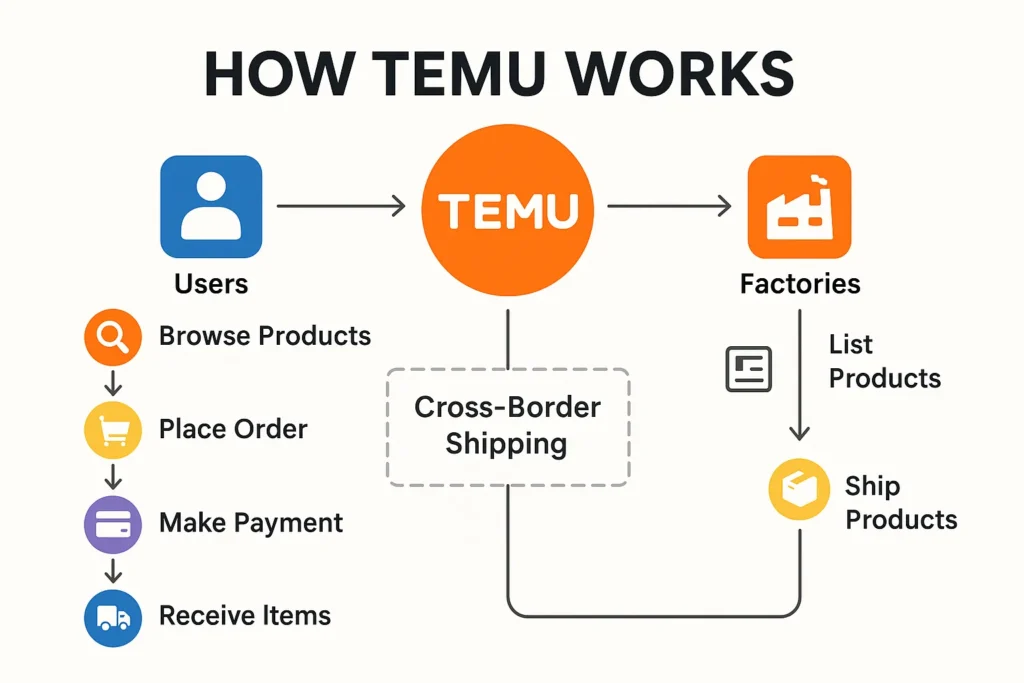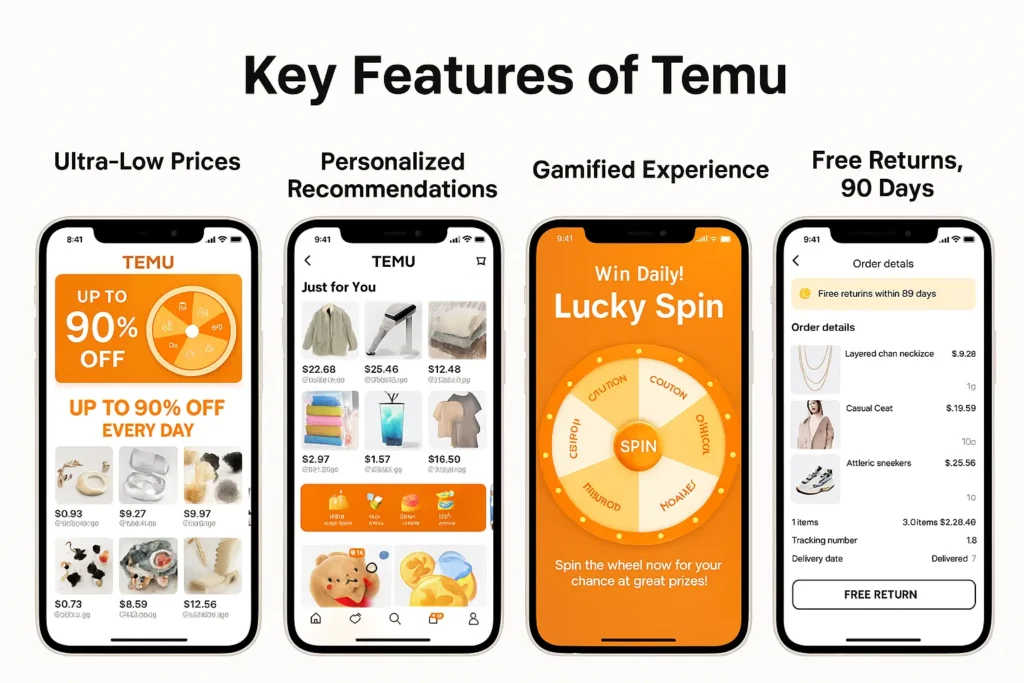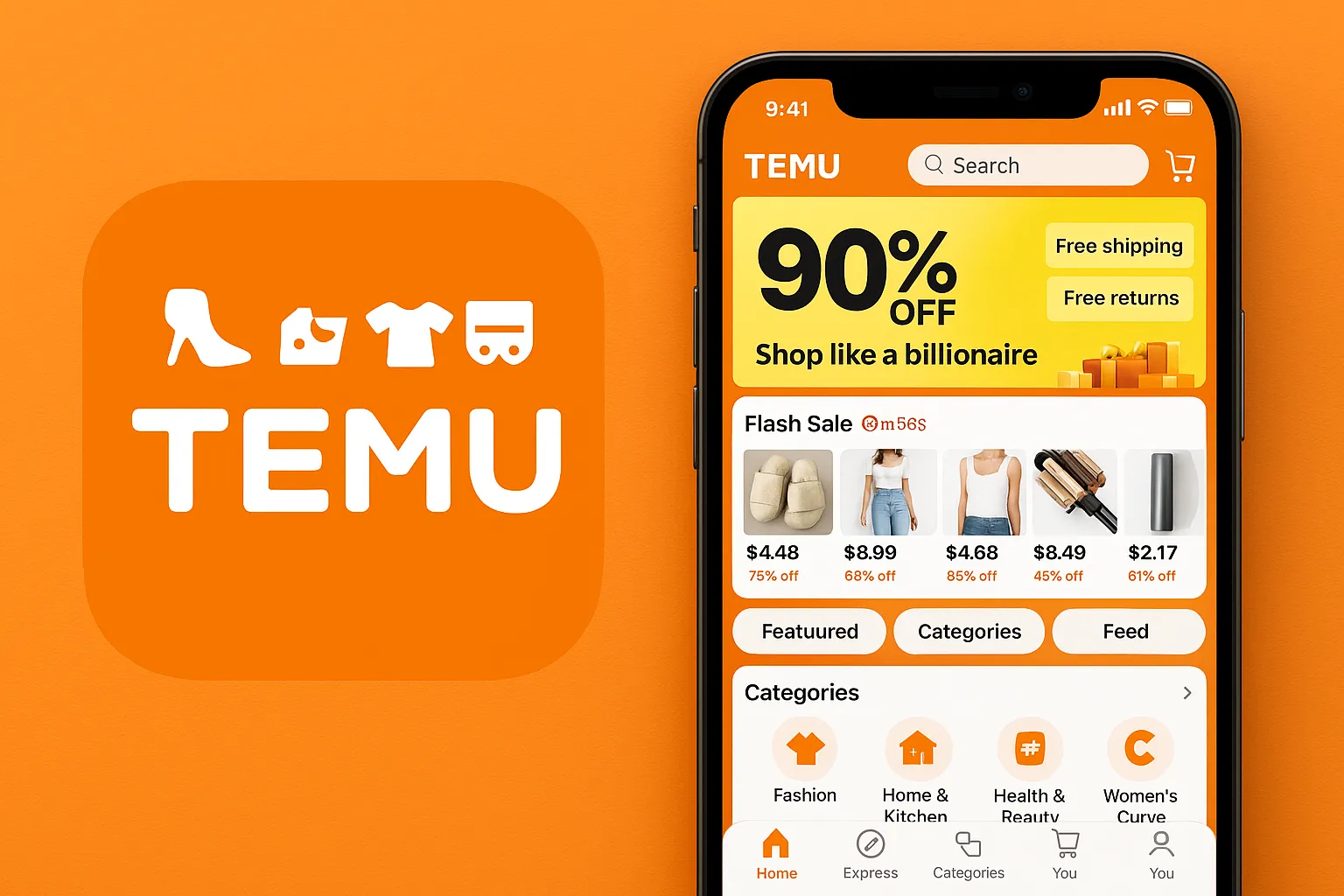Imagine wanting trendy clothes, home décor, gadgets, and beauty items — all at unbelievably low prices, delivered to your doorstep from global suppliers. That’s exactly the convenience millions of shoppers get every day with Temu, one of the most viral eCommerce apps across the USA, Europe, and Asia.
Launched in September 2022 by PDD Holdings (parent company of Pinduoduo), Temu quickly disrupted global eCommerce by blending ultra-low pricing, direct-from-factory sourcing, and aggressive social promotions. By 2024–2025, it became one of the top downloaded shopping apps in the world, crossing 200M+ active users and shaking major marketplaces like Amazon, Shein, and AliExpress.
Temu’s rise is a story of smart supply chains, irresistible deals, gamified buying experiences, and a frictionless mobile-first ecosystem — making it a case study for modern eCommerce innovation.
What Is Temu? The Simple Explanation
Temu is a global online shopping app that connects customers directly to factories and suppliers—mainly in China—allowing them to buy products at extremely low prices. Instead of traditional retail markups, Temu uses a factory-to-consumer (F2C) model, meaning buyers get items straight from manufacturers without middlemen. This keeps costs low while offering thousands of categories from fashion to electronics to home improvement.
The Core Problem Temu Solves
People want affordable products without compromising on variety. Traditional eCommerce often inflates prices due to supply chain layers. Temu removes these layers and gives shoppers ultra-low prices, endless choices, and fast delivery despite global shipping.
Target Users & Use Cases
- Budget-conscious shoppers
- Trend-focused Gen Z buyers
- Home improvement & décor shoppers
- Gadget lovers
- Gift shoppers looking for variety
- Bargain hunters comparing prices to Amazon/Shein
Common use cases:
✔ Trendy fashion at low prices
✔ Affordable gadgets & accessories
✔ Home décor refresh
✔ Beauty & skincare items
✔ Gift bundles and seasonal deals
Current Market Position (2025 Stats)
- 200M+ active users globally
- Top #1 or #2 shopping app in the USA multiple times in 2024–2025
- Operates in 50+ countries
- Avg order value: $25–$35
- Over 100,000+ factories selling through the platform
- Ranked among the fastest-growing eCommerce platforms in 2025
Why Temu Became So Successful
- Factory-direct pricing structure
- Massive product variety (30+ categories, millions of listings)
- Viral marketing, gamified rewards, referrals, deals
- Fast global logistics through PDD Holdings’ supply chain
- AI-driven recommendations, dynamic pricing & personalization
Read more: Building an Ecommerce App: A Comparative Guide for Startups and Enterprises
How Does Temu Work? Step-by-Step Breakdown
Temu operates on a factory-to-consumer (F2C) marketplace model, where shoppers browse millions of products listed directly by manufacturers. Temu manages logistics, payments, quality control, and customer support — while factories handle production. Below is a clear breakdown for users, sellers, and the technical side.
For Users: How Temu Works (Step-by-Step)
1. Account Creation
- Sign up via email, phone number, Google, or Apple ID
- Choose location → Temu auto-adjusts currency & delivery options
- New users often receive welcome coupons, free shipping, or gift rewards
2. Product Browsing & Discovery
- AI-powered personalized feed
- Categories: Fashion, Home, Beauty, Electronics, Pet Supplies, DIY, etc.
- Daily flash deals, lightning sales, limited-time offers
- Gamified rewards (spin wheels, discounts, referral bonuses)
3. Add to Cart & Checkout
- Temu displays shipping time (usually 6–14 days in USA/EU)
- Bulk shipping with consolidated packages reduces cost
- Multiple payment options:
- Credit/debit cards
- PayPal
- Klarna & Afterpay (Buy Now Pay Later)
- Temu credit/refund balance
4. Order Processing
- Temu collects orders → Sends them to manufacturers
- Manufacturers pack and send items to Temu export centers
- Temu optimizes shipments in consolidated cargo
5. Delivery & Tracking
- Real-time tracking through Temu app
- Partners with major global couriers (UPS, USPS, FedEx, DHL, Yanwen, etc.)
- “Delivery Guarantee” ensures refund if items arrive late
6. Returns & Customer Support
- Free returns within 90 days (USA)
- Refund options:
- Instant credit
- Full refund
- Item replacement
Temu handles all customer service, not the factories.
For Service Providers / Sellers (Factories)
1. Onboarding Process
- Factories apply to join Temu Supplier Program
- Temu verifies:
- Production capacity
- Product quality
- Certifications
- Compliance
2. Listing Products
- Sellers upload product data (photos, descriptions, variants)
- Temu uses AI to optimize listings & pricing
3. Fulfillment Workflow
- Sellers manufacture items after receiving orders
- They ship products to Temu’s warehouse hubs
- Temu takes over logistics, packaging, and final delivery
4. Earnings + Commission Structure (2025)
- Factories operate under a consignment model
- Temu controls pricing; sellers earn per-unit share
- Commission model varies by category:
- 5–20% per item depending on type
- Temu also charges:
- Storage fees (for inventory kept in Temu warehouses)
- Return fees if item quality fails
Sellers benefit from massive global exposure without spending on marketing.
Technical Overview (Simple Explanation)
Temu’s backend is designed like a modern, scalable global marketplace.
1. Basic Architecture
- Mobile App + Web Frontend
- Marketplace Backend managing:
- Seller management
- Order processing
- Payments
- Support workflows
- AI Layer for recommendations, pricing, reviews, fraud detection
- Logistics & Tracking System for cross-border shipping
2. Key Technologies
- React Native / Flutter (mobile)
- React / Vue (web frontend)
- Python, Go, and Java microservices
- AI/ML for pricing, personalization, and dynamic recommendations
- Big data pipelines for handling millions of daily transactions
- Cloud hosting (multi-region distributed servers)

Temu’s Business Model Explained
Temu’s business model is built on ultra-efficient supply chains, factory partnerships, and aggressive pricing strategies — making it one of the most disruptive eCommerce apps of 2025. Here’s a clear breakdown.
How Temu Makes Money (All Revenue Streams)
Temu operates primarily on a consignment-based marketplace model, but also earns from several additional streams:
1. Commission on Product Sales
Temu takes a commission from sellers (factories) on each sale.
- Commission Rate (2025): 5%–20% depending on category.
2. Logistics & Fulfillment Fees
Sellers may pay fees for:
- Warehousing
- Packaging
- Consolidated shipping services
- Return handling
3. Advertising & Sponsored Listings
Sellers can pay Temu to rank higher in search results (similar to Amazon Ads).
4. Data-Driven Pricing Optimization
Temu uses AI to adjust prices dynamically.
It sometimes sells at a loss for customer acquisition, then earns back through volume & long-term retention.
5. Cross-Border Shipping Agreements
Bulk exports through optimized shipping reduce cost — Temu keeps the difference as margin.
6. Buy Now, Pay Later Partnerships
Temu earns small revenue share when users pay with Klarna, Afterpay, or other BNPL methods.
7. Affiliate Programs & Referral Bonuses
External influencers drive traffic, contributing to low-cost viral acquisition.
Pricing Structure (2025)
- Average product price: $5–$25
- Delivery: Usually free, especially for new users
- Returns: Free within 90 days (USA)
- Shipping time: 6–14 days typical
Temu’s low pricing is enabled by:
- Direct-from-factory sourcing
- Bulk shipping
- Zero retail markup
- High-volume order scale
Read more: Business Model for E-commerce Apps
Commission/Fee Breakdown (2025)
| Revenue Source | Typical Rate | Notes |
| Seller Commission | 5–20% | Based on product category |
| Warehousing Fees | Variable | For storing items in Temu hubs |
| Return Chargeback | Case-based | If product fails quality checks |
| Sponsored Ads | Custom | Sellers pay for ranking boosts |
| Cross-border Shipping Margin | 10–30% savings | Temu keeps efficiency margin |
Market Size & Growth Stats (2025)
- Global cross-border eCommerce: $5 trillion market
- Temu app downloads: 200M+
- Annual GMV growth: Over 60% YoY
- Global expansion: 50+ countries
- Competes with Shein, Amazon, AliExpress
Temu’s rapid expansion is fueled by the success of low-cost manufacturing ecosystems.
Profit Margins Insights
Temu often operates at thin margins or temporary losses to scale globally.
The platform relies on:
- Massive order volume
- AI-driven pricing
- Logistics optimization
- Reduced middlemen cost
Once it scales, Temu profits from ad revenue, logistics margins, and repeated purchases.
Key Features That Make Temu Successful
Temu’s explosive global growth isn’t accidental — it’s powered by a strategic mix of technology, psychology, pricing, and user experience. Below are the 10 key features that make Temu one of the most successful eCommerce apps in 2025.
1. Ultra-Low Pricing Engine
Why it matters: Users get products 50–90% cheaper than retail.
Benefit: Huge savings, increased impulse buying.
Tech behind it: AI-driven dynamic pricing + factory-direct sourcing.
2. Millions of Product Listings
Why it matters: More variety than typical marketplaces.
Benefit: “Everything store” convenience.
Tech: Big data catalog management, auto-tagging.
3. Gamified Shopping Experience
Includes spin wheels, coupons, daily rewards, free gifts.
Benefit: Higher engagement & retention.
Tech: Behavioral gamification algorithms.
4. Personalized Home Feed
Why it matters: Shows products that match user behavior.
Benefit: Users find relevant products faster.
Tech: Machine learning recommendation engine.
5. AI-Based Logistics Optimization
Why it matters: Despite low cost, deliveries remain fast & tracked.
Benefit: Smooth cross-border shipping.
Tech: AI route selection, cargo consolidation, smart fulfillment.
6. Social Sharing & Referral Features
Users earn credits for inviting friends.
Benefit: Viral growth without heavy ad spend.
Tech: In-app referral tracking system.
7. Secure Payments + BNPL Options
Supports PayPal, cards, Klarna, Afterpay.
Benefit: Increased trust and flexibility.
Tech: Encrypted payment gateways, fraud detection.
8. Free Returns & 90-Day Guarantee
Benefit: Reduces customer risk.
Tech: Automated return authorization & refund system.
9. Real-Time Order Tracking
Benefit: Transparency for cross-border shipments.
Tech: Logistics API integrations (UPS, USPS, DHL, FedEx).
10. AI-Assisted Product Photos & Reviews
Benefit: Better buying decisions.
Tech: Image recognition + review authenticity scoring.
Recent 2025 Updates
- Faster U.S. shipping through new logistics hubs
- AI-driven image cleanup for sellers
- Upgraded fraud detection & review authenticity algorithm
- “Temu Choice” premium quality program
- New BNPL partners for the U.S. and EU markets
AI/ML Integrations in Temu
- Dynamic pricing engine
- Recommendation feed
- Demand prediction models
- Smart logistics routing
- Fraud & fake review detection
- Automated coupon optimization
These AI features enable Temu to scale while keeping costs low.
What Sets Temu Apart from Competitors
- Factory-to-consumer model (F2C)
- Extremely low prices without reducing product variety
- Aggressive gamification
- Global expansion at record speed
- AI-driven logistics and pricing
- Viral social marketing strategies

The Technology Behind Temu
Temu’s global success is powered by a modern, scalable, AI-heavy technology ecosystem. Even though shoppers see only low prices and fast delivery, behind the scenes Temu runs a highly optimized tech stack designed for millions of daily transactions.
Simplified Tech Stack Overview (2025)
Frontend
- Mobile: React Native + some Flutter-based modules
- Web App: React, Next.js, TypeScript
- UI System: Modular component library for fast release cycles
Backend
- Microservices architecture (Go, Java, Python)
- Event-driven communication (Kafka, RabbitMQ)
- Distributed systems for handling scale
- AI services connected to the core commerce engine
Database & Storage
- MySQL / PostgreSQL for transactional operations
- Redis / Memcached for caching high-traffic endpoints
- MongoDB / Elasticsearch for product search & catalog
- CDN caching for images & static assets
Real-Time Features Explained
1. AI-Powered Recommendation Engine
- Tracks browsing behavior
- Predicts preferences
- Delivers personalized feed within milliseconds
2. Dynamic Pricing System
- Adjusts prices based on demand, stock, trends, and competition
- Ensures Temu remains cheaper than Amazon, Shein, or AliExpress
3. Smart Logistics Engine
- Estimates fastest shipping route
- Groups orders for bulk delivery
- Real-time partner courier updates (UPS, USPS, FedEx, DHL)
4. Real-Time Fraud Detection
- Monitors abnormal purchase behavior
- Blocks suspicious seller or buyer activity
Data Handling & Privacy
Temu uses a global data architecture aligned with:
- GDPR (Europe)
- CCPA (USA)
- PIPL (China)
Key data safeguards:
- Encrypted user data
- Tokenized payment information
- Anonymized behavioral data for AI training
- Secure server access controls
Scalability Approach
Temu is built to handle:
- Millions of concurrent users
- Real-time product updates
- Thousands of factory uploads per day
Scaling strategies Temu uses:
- Auto-scaling cloud clusters
- Containerization (Docker, Kubernetes)
- Multi-region server deployment
- Edge caching for fast load times across continents
API Integrations
Temu integrates with:
- Global logistics APIs (FedEx, DHL, USPS)
- Payment gateways (PayPal, Stripe, BNPL partners)
- AI cloud services
- Review verification tools
- Pricing and inventory automation systems
APIs enable Temu to operate seamlessly in 50+ countries.
Why This Tech Matters for Business
- Enables ultra-low pricing
- Ensures reliable global delivery
- Supports millions of products
- Reduces operational overhead
- Enhances personalization → more sales
- Strengthens customer trust & retention
This robust technology foundation is a key reason Temu can scale faster than traditional eCommerce players.
Temu’s Impact & Market Opportunity
Temu hasn’t just entered the global eCommerce market — it has reshaped it. From pricing expectations to supply chain strategy, Temu has forced competitors to rethink how they operate. Here’s a clear look at its industry impact and the massive opportunities it has opened for entrepreneurs.
Temu’s Industry Disruption
1. Price Disruption (Biggest Impact)
Temu normalized ultra-low pricing across categories.
Amazon, Walmart, and Shein have all been pressured to adjust pricing or launch more aggressive discount campaigns.
2. Cross-Border Logistics Transformation
Before Temu, cross-border eCommerce was known for:
- Long delivery times
- High shipping fees
- Unpredictable tracking
Temu’s AI-powered consolidated shipping changed the game — now fast, low-cost global shipping is becoming an industry standard.
3. Rise of Factory-to-Consumer (F2C)
Temu proved that direct-from-manufacturer is the future of affordable retail.
Factories now prefer selling on Temu-like platforms instead of relying only on wholesalers.
4. Gamified Shopping Trend
Temu’s gamification features have inspired clones worldwide:
- Spin wheels
- Daily check-in rewards
- Task-based discounts
- Referral bonuses
These elements increase retention and conversion dramatically.
Market Statistics & Growth (2025)
Global eCommerce Market (2025)
- Valued at $8.1 trillion
- Cross-border segment: $5 trillion
- F2C marketplaces growing at 40%+ YoY
Temu-Specific 2025 Stats
- 200M+ active global users
- Available in 50+ countries
- Estimated GMV: $35B+
- App download growth: Top 3 global shopping apps for 2024–2025
- Average order value: $25–$35
- Repeat purchase rate: Over 50%
Temu continues to gain market share in both the USA and Europe.
User Demographics & Behavior
- Gen Z & Millennials: 18–34 age group dominates
- Bargain-focused shoppers
- Social media-driven buyers
- High engagement with deals & gamified activities
- Users often purchase multiple low-ticket items at once
Global Geographic Presence
Major markets in 2025:
- United States
- Canada
- UK
- France
- Germany
- Australia
- Middle East
- Southeast Asia
Temu’s localization strategy (currency, language, regional deals) accelerates adoption.
Future Projections (2025–2030)
Analysts predict:
- Temu may reach 400M+ users by 2030
- F2C marketplaces will grow faster than traditional eCommerce
- More factories will join global platforms
- AI-powered logistics will shrink delivery times even further
- Emerging markets (India, Southeast Asia, Latin America) will boost global adoption
Opportunities for Entrepreneurs
Temu’s success opened new doors:
1. F2C Marketplace Startups
More entrepreneurs are building Temu-like apps using:
- Factory-direct sourcing
- Low-cost supply chains
- Mobile-first shopping models
2. Niche “Temu Clone” Marketplaces
Examples:
- Low-cost fashion marketplaces
- Gadget-specific bargain apps
- Home décor factory-to-home platforms
- Beauty & skincare direct-from-manufacturer apps
3. Localized Temu Alternatives
Temu competitors focusing on:
- Faster domestic delivery
- Local vendors
- Specific regional categories
4. AI-Driven Commerce Platforms
Demand for AI recommendation systems, pricing engines, and personalized feeds continues to soar.
Natural Transition into Development
This massive success is why many entrepreneurs, startups, and brands are exploring ways to build their own Temu-like platform using proven clone scripts and customizable marketplace solutions.
Building Your Own Temu-Like Platform
Temu’s explosive growth has inspired thousands of entrepreneurs to explore launching similar marketplaces. With the right strategy, technology, and execution, creating a Temu-like platform is absolutely achievable — especially using modern clone scripts and ready-made marketplace frameworks.
Why Businesses Want a Temu Clone
1. Demand for Ultra-Affordable Shopping
Users worldwide now expect:
- Lower prices
- Direct-from-factory deals
- Fast cross-border delivery
A Temu-style platform perfectly fits this shift.
2. The F2C (Factory-to-Consumer) Model Works
Instead of multiple middlemen, factories sell directly to customers — boosting margin and volume on both sides.
3. Proven Business Model
Temu’s success reduces guesswork for new marketplace founders:
- High engagement
- Repeat orders
- Strong viral cycles
- Global scalability
4. Huge Market Size & Growth
Cross-border eCommerce is projected to cross $5T+, creating opportunities in:
- Fashion
- Electronics
- Home décor
- Beauty
- Pet supplies
- DIY tools
Key Considerations Before Development
To build a successful Temu-like marketplace, founders must consider:
1. Vendor Strategy
- Onboarding verified factories
- Ensuring quality control
- Inventory consistency
- Pricing transparency
2. Logistics & Shipping
- Consolidated shipping
- Multi-country delivery partners
- Real-time tracking APIs
- Optional local warehouses
3. Technology Infrastructure
- Mobile apps (iOS/Android)
- Powerful product catalog
- AI recommendation engine
- Dynamic pricing system
- Secure payments
- Multi-region deployment
- Gamification modules
4. Compliance
- GDPR / CCPA / PIPL
- Cross-border tax policies
- Return policies
5. Marketing & User Acquisition
- Referral systems
- Welcome offers
- Flash sales
- Social media virality
Cost Factors & Pricing Breakdown
Temu-Like App Development — Market Price
| Development Level | Inclusions | Estimated Market Price (USD) |
| Basic Cross-Border Marketplace MVP | Product listings, basic F2C flow, simple checkout | $80,000 |
| Mid-Level Global Marketplace | Seller/factory dashboards, multi-currency, mobile apps, shipping integrations | $180,000 |
| Advanced Marketplace (Temu-scale) | High concurrency backend, factory APIs, promotions engine, global logistics, AI recommendations, native apps | $250,000+ |
These costs represent the global price of building a Temu-style marketplace from scratch—typically taking 6–12 months depending on logistics and scale.
Miracuves Temu-Style Marketplace Pricing
Miracuves Price: Starts at $14,999
This delivers a full-featured Temu-style cross-border marketplace with factory onboarding, global product catalog, multi-currency checkout, logistics-ready architecture, real-time deals, and mobile apps—built for scale and high-performance F2C operations.
Note: This includes full non-encrypted source code, complete deployment support, backend setup, admin panel configuration, and publishing on Google Play Store & Apple App Store—giving you a fully operational marketplace ready for launch.
Delivery Timeline for Temu-Style Marketplace
Miracuves development timeline including setup, configuration, admin deployments, API integrations, and platform handover in approximately 30–90 days, depending on customization and additional functional layers requested. This ensures a stable, market-ready system with predictable delivery and no hidden engineering delays.
Tech Stack
We preferably use JavaScript (Node.js + Next.js + PostgreSQL) for the platform and Flutter/React Native for mobile apps, ensuring global scalability and lightning-fast performance. Other tech stacks can be discussed and arranged upon request — Contact us
Essential Features to Include
To compete with Temu, your platform must offer:
- Factory/vender onboarding
- Multi-vendor catalog
- Flash sale engine
- Gamification tools
- AI search & recommended feed
- Global checkout + BNPL
- Customer support automation
- Real-time order tracking
- Review & rating system
- Analytics dashboard
Conclusion
Temu’s incredible rise from a newcomer to a global eCommerce powerhouse proves one thing clearly: the future of online shopping is fast, affordable, and factory-direct. By combining ultra-low pricing, AI-powered personalization, and a highly optimized cross-border logistics network, Temu has reshaped how millions of people buy everyday products in 2025.
Its success highlights a major shift in consumer behavior — people want more variety, better deals, and smooth mobile-first experiences. And Temu delivers all three with unmatched efficiency.
For entrepreneurs, the opportunity is massive. The factory-to-consumer (F2C) model, AI-driven recommendation engines, and gamified shopping experiences are no longer limited to billion-dollar companies. With modern technology and Miracuves’ ready-made marketplace solutions, any founder can build a Temu-like app and enter this booming market with confidence.
FAQs
Q:1 How does Temu make money?
Temu makes money through commissions on sales (5–20%), logistics service fees, sponsored product ads, cross-border shipping margins, and partnerships with BNPL payment providers.
Q:2 Is Temu available in my country?
As of 2025, Temu is available in 50+ countries, including the USA, UK, Canada, Australia, most of Europe, and parts of the Middle East and Asia. It continues expanding rapidly.
Q:3 How much does Temu charge users?
Temu does not charge any extra fees to users. Most items include free shipping, and returns are free within 90 days in eligible countries. Users simply pay the product price at checkout.
Q:4 What’s the commission for Temu’s service providers (factories)?
Temu charges factories a 5–20% commission depending on category, along with storage or return fees if items don’t meet quality guidelines.
Q:5 How does Temu ensure safety and quality?
Temu ensures safety through strict supplier verification, AI-based review monitoring, secure payments, fraud detection, and quality checks at logistics hubs before global shipping.
Q:6 Can I build something similar to Temu?
Yes, you can build a Temu-like app using a ready-made marketplace script or a custom eCommerce solution. Miracuves offers complete Temu clone development with features like F2C sourcing, AI recommendations, gamification, and global shipping modules.
Q:7 What makes Temu different from competitors like Amazon or Shein?
Temu stands out for its ultra-low factory-direct pricing, massive product variety, aggressive gamification, and AI-driven global logistics, making it one of the most cost-efficient shopping apps.
Q:8 How many users does Temu have in 2025?
Temu has over 200 million active users in 2025 and ranks among the top 3 most downloaded shopping apps worldwide.
Q:9 What technology does Temu use?
Temu uses a modern tech stack including React Native, Go, Python microservices, big-data search engines, AI recommendation systems, dynamic pricing algorithms, and global logistics APIs.
Q:10 How can I create an app like Temu?
You can create a Temu-like app using a ready-made clone solution that offers global marketplace architecture, vendor onboarding, logistics integration, and full customization.
Related Articles:








